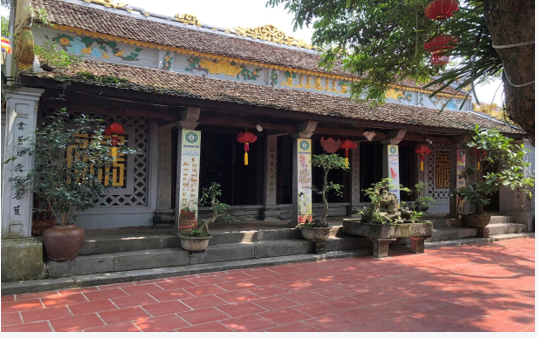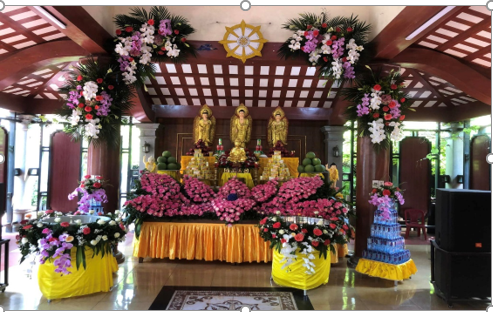Phuc Nhac pagoda (Gia Le pagoda) is an ancient pagoda, located in Chua hamlet, Khanh Nhac commune, Yen Khanh district, Ninh Binh province. The pagoda was built in the late Tran dynasty (1603) in the Minh Menh year of the Nguyen dynasty (1820-1840). The pagoda faces north, located on a land area of about 3,310 m2, and has been recognized by the state as a national historical and cultural relic.

Phuc Nhac Pagoda was built during the Later Tran Dynasty (1603), named Gia Le Tu Pagoda. In the early days, the pagoda was just a small hut with mud walls and thatched roof, built by the people to worship Buddha and pray. It was managed by the people. Only in the early 17th century did a monk come to lead it. In the early 18th century (10th year of Gia Long), the pagoda was rebuilt with tiled roofs and walls. After the restoration process, the temple was built with its present appearance.

Phuc Nhac Pagoda was the residence and working place of the envoy Nguyen Cong Tru during the early days of land reclamation to establish Kim Son district in the year of the Ox (1829). Thanks to the help of the abbot at Phuc Nhac Pagoda, Nguyen Cong Tru had favorable conditions in the work of reclaiming the coastal mudflats to establish Kim Son district.
The pagoda is the place where monk Pham Duc Nhuan, Chairman of the Unified Buddhist Association of Vietnam, received ordination. At the end of 1947, under the leadership of the Party and the Viet Minh front, the Buddhist Association for National Salvation of Ninh Binh province was organized at the pagoda. Phuc Nhac, monk Phan Thanh San was elected president of the Buddhist Association for national salvation in Ninh Binh province. Under the leadership of the Party, Uncle Ho, Viet Minh front, Yen Khanh District Buddhist Association established the semi-armed Buddhist Youth with 186 members, of which the majority were Buddhist Youth from Nhac Pagoda participating, here was the core force to participate in the revolutionary struggle movement of the period 1947-1949 in the locality.
Since the August 1945 revolution, the resistance war against the French colonialists, the resistance war against the US to save the country, Chua Phuc Nhac has been a solid base of the revolution, a place for secret activities of party cells, and a center for alliances. To contact, store, and receive official dispatches, documents, and news for resistance activities in enemy areas, many monks both performed religious duties and actively participated in revolutionary activities, typically Phan Thanh San, Hoang Thanh Bang, monk Mr. Thai, monk Mr. Cao...
About the architecture of Phuc Nhac Pagoda

Phuc Nhac Pagoda is located near the center of the commune, on a campus with an area of 3,310 m2, under rows of ancient trees and perennial trees that are green all year round. The pagoda faces west, the north, east, and west sides are adjacent to people's houses, and the south is the temple pond. Through the Tam Quan gate and into the tiled courtyard is a building with 5 compartments, two floors, 4 roofs. Next to Tam Quan's house is a small tiled yard. Across the yard is a 6-room front house with square stone columns each 25cm long, 2.5m high, and delicately carved with flowers and leaves of the Nguyen Dynasty. Next to the Tien Duong house is the Three Jewels house with 4 vertical compartments. In the Three Jewels, Buddha is worshiped with a system of beautiful statues, the most beautiful being the bronze Mekong tower. .. From the outside, on the left side is the ancestral house with 5 front rooms, 2 back rooms and a row of main halls which are guest houses, old houses, and warehouses. The entire temple complex has up to 45 solid houses of all kinds. In front, on the left is a system of 8 solidly built towers, carved with patterns, which is the place of death of the abbots who lived here. The temple's buildings are built as a closed system, a continuous system that does not separate one house from another
Phuc Nhac Pagoda is quite rich in types and materials, including stoneware, wooden objects, porcelain, and bronze, and currently retains a number of precious relics such as:
- A large bronze bell cast in the 10th year of Gia Long
- The bronze statue of the Kowloon Buddha was cast in the thirteenth year of Bao Dai (1938)
- A system with 17 stone inscriptions called post-Buddha inscriptions is a unique art, an extremely valuable relic.
- Ancient stone incense bowl of the Nguyen Dynasty
The pagoda also has quite unique architectural works such as the 4-roof Ancestral Church, the entire front is built of stone, decorated with patterns, parallel sentences...

Annual festival at Phuc Nhac Pagoda
In addition to holding the annual Buddha's Birthday ceremony on the 15th day of the fourth lunar month, the pagoda also organizes annual weeks such as: Thuong Nguyen ceremony on January 15, Trung Nguyen ceremony on July 15, also known as Vu Lan ceremony, Buddha ceremony. Thich Ca attained enlightenment on December 15. Every 6 years, Phuc Nhac Pagoda holds a fast to pray for the souls in the second lunar month, lasting 5-7 days (ceremony at the pagoda for 3 days, 1 day the villages process the Emperor to the pagoda for naturalization, 1 day to pick up).
Reference materials
1. Decision No. 1999 dated January 12, 1999 of the Minister of Culture
Information on relic recognition
2. History of Gia Le Tu Pagoda
3. Field survey data in Khanh Nhac commune, Yen Khanh district, Ninh Binh province
4. Collection of photos depicting the relics of Phuc Nhac Pagoda taken on March 22, 1998